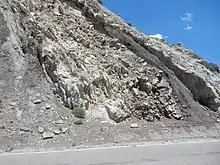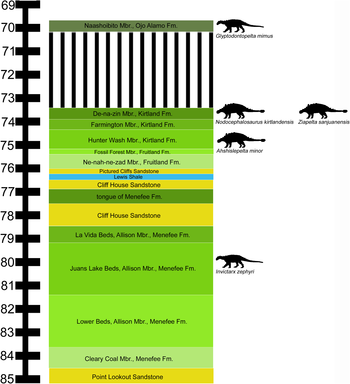Menefee Formation
The Menefee Formation is a Campanian geologic formation of New Mexico, United States.
| Menefee Formation Stratigraphic range: Early Campanian | |
|---|---|
 Menefee Formation in a road cut through a hogback ridge near Cuba, New Mexico. | |
| Type | Geological formation |
| Unit of | Mesaverde Group |
| Sub-units | Cleary Coal Member, Allison Member |
| Underlies | Cliff House Sandstone |
| Overlies | Point Lookout Sandstone |
| Thickness | 500 m (1,600 ft) |
| Lithology | |
| Primary | sandstone, shale |
| Other | coal |
| Location | |
| Coordinates | 37°19′37″N 108°14′56″W |
| Region | |
| Country | |
| Type section | |
| Named for | Menefee Mountain (37°19′37″N 108°14′56″W) |
| Named by | A.J.Collier |
| Year defined | 1919 |

Description
The Menefee Formation consists of fluvial sandstone, shale, and coal. Age estimates from ammonite biostratigraphy, palynostratigraphy, and direct radiometric dating are discrepant but the most likely age is around 81 Ma, corresponding to the early Campanian.[1]
Named members include a lower Cleary Coal Member and an upper Allison Member.[1]
The Mesaverde Group in the San Juan Basin records a regression-transgression sequence of the western margin of the Western Interior Seaway. The Menefee Formation was deposited at the peak of the regression as coastal delta and swamp sediments, and includes numerous coal beds.[1][2]
The formation is exposed at Chaco Canyon National Park, where many of the coal beds have been burned to produce distinctive red cinder outcrops.[3]
Fossils
The Menefee Formation includes fossils of turtles, fish and crocodiles and fragmentary evidence of hadrosaurs, ankylosaurs, ceratopsian dinosaurs, and mosasaurs. Plant fossils include leaf impressions of palms, conifers, laurels, witchhazel, and camellia. The flora are suggestive of a moist subtropical environment.[4]
Vertebrate fauna
Several vertebrates have been recovered from the Menefee Formation, including intermediate remains of baenids, trionychids, hadrosaurids and dromaeosaurids, and two species of troodontids. An unnamed centrosaurine ceratopsid is also known.[5]
| Dinosaurs reported from the Menefee Formation | ||||||
|---|---|---|---|---|---|---|
| Genus | Species | Stratigraphic position | Material | Notes | Images | |
| Dynamoterror[6] |
D. dynastes |
|
"left and right frontals, four fragmentary vertebral centra, dorsal rib fragments"[6] |
|||
| Invictarx[7] |
I. zephyri |
|
"incomplete postcranial skeleton" |
|||
| Crocodilians reported from the Menefee Formation | ||||||
|---|---|---|---|---|---|---|
| Genus | Species | Stratigraphic position | Material | Notes | Images | |
| Brachychampsa[8] |
B. sealeyi |
|
"partial skull, associated partial mandible, and a dorsal osteoderm" |
An alligatoroid |
| |
| Deinosuchus[9] |
|
"two caudal vertebrae and several large osteoderms" |
An alligatoroid |
| ||
Economic geology
The Menefee Formation has been extensively mined for coal since the early 20th century.[10] The Monero field in Rio Arriba County, New Mexico, was mined from the 1880s into the early 1920s to support the Denver and Rio Grande Western Railroad, but while the coal is of good quality, the coal beds are relatively thin and the terrain is rugged. Remaining reserves are around 13.5 million tons, inadequate for economic exploitation in the 21st century.[11]
History of investigation
The Menefee Formation was first described by W.H.Holmes in 1877 during the Hayden Survey as the "Middle Coal Group" of the Mesaverde Formation.[12] A.J. Collier redesignated this unit in 1919 as the Menefee Formation and raised the Mesaverde Formation to group rank.[10]
See also
- List of dinosaur-bearing rock formations
References
- Lucas et al. 2005
- Fillmore 2011
- Scott et al. 1984
- National Park Service 2015
- Williamson TE. 1997. A new Late Cretaceous (early Campanian) vertebrate fauna from the Allison Member, Menefee Formation, San Juan Basin, New Mexico. In: Lucas SG, Estep JW, Williamson TE, Morgan GS, eds. New Mexico’s Fossil Record 1. Albuquerque: New Mexico Museum of Natural History and Science Bulletin 11. 51-59.
- McDonald, A.T.; Wolfe, D.G.; Dooley Jr, A.C. (2018). "A new tyrannosaurid (Dinosauria: Theropoda) from the Upper Cretaceous Menefee Formation of New Mexico". PeerJ. 6: 6:e5749. doi:10.7717/peerj.5749. PMC 6183510. PMID 30324024.
- McDonald, AT; Wolfe, DG (2018). "A new nodosaurid ankylosaur (Dinosauria: Thyreophora) from the Upper Cretaceous Menefee Formation of New Mexico". PeerJ. 6: e5435. doi:10.7717/peerj.5435. PMC 6110256. PMID 30155354.
- Williamson, TE (1996). "Brachychampsa sealeyi, sp. nov., (Crocodylia, Alligatoroidea) from the Upper Cretaceous (lower Campanian) Menefee Formation, northwestern New Mexico". Journal of Vertebrate Paleontology. 16 (3): 421–431. doi:10.1080/02724634.1996.10011331.
- https://www.researchgate.net/publication/242304833_The_giant_crocodylian_Deinosuchus_from_the_Upper_Cretaceous_of_the_San_Juan_Basin_New_Mexico
- Collier 1919
- Hoffman 1991
- Holmes 1877
Bibliography
- Collier, A.J., 1919, Coal south of Mancos, Montezuma County, Colorado, IN Contributions to economic geology, 1918; Part 2, Mineral fuels: U.S. Geological Survey Bulletin, 691-K, p. K293-K310.
- Fillmore, Robert (2011). Geological evolution of the Colorado Plateau of eastern Utah and western Colorado, including the San Juan River, Natural Bridges, Canyonlands, Arches, and the Book Cliffs. Salt Lake City: University of Utah Press. pp. 224, 247–248. ISBN 978-1-60781-004-9.
- Hoffman, Gretchen K. (February 1991). "Geology and quality ol Menefee Formation coals, Monero coal field, Rio Arriba County, New Mexico" (PDF). New Mexico Geology. 13 (1). Retrieved 8 June 2020.
- Holmes, W.H., 1877, Report [on the San Juan District, Colorado], IN Hayden, F.V., Ninth annual report of the United States Geological and Geographical Survey of the Territories, embracing Colorado and parts of adjacent territories, being a report of progress of the exploration for the year 1875; Part I, Geology: U.S. Geological and Geographical Survey of the Territories (Hayden), Annual Report, 9, p. 237-276, pls. 34-49., Reprint, 1873
- Lucas, Spencer G.; Spielmann, Justin A.; Braman, Dennis R.; Brister, Brian S.; Peters, Lisa; McIntgosh, William C. (2005). "Age of the Cretaceous Menefee Formation, Gallina Hogback, Rio Arriba County, New Mexico" (PDF). New Mexico Geological Society Field Conference Series. 56. Retrieved 8 June 2020.
- "Menefee Formation". Chaco Canyon National Historical park. National Park Service. Retrieved 8 June 2020.
- Scott, G.R., O'Sullivan, R.B., and Weide, D.L., 1984, Geologic map of the Chaco Culture National Historical Park, northwestern New Mexico [includes chapter on archaeology by W.B. Gillespie]: U.S. Geological Survey Miscellaneous Investigations Series Map, I-1571, scale 1:50,000
- Weishampel, David B.; Dodson, Peter; and Osmólska, Halszka (eds.): The Dinosauria, 2nd, Berkeley: University of California Press. 861 pp. ISBN 0-520-24209-2.

